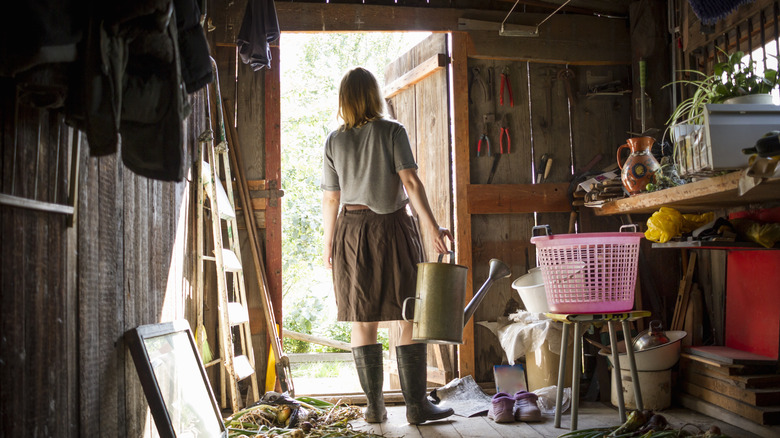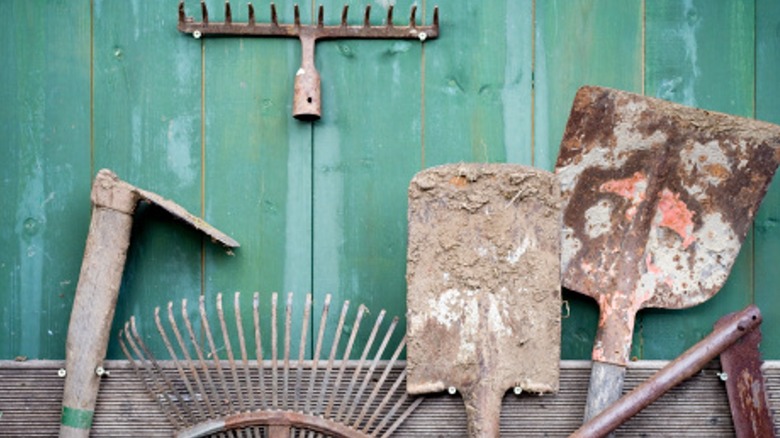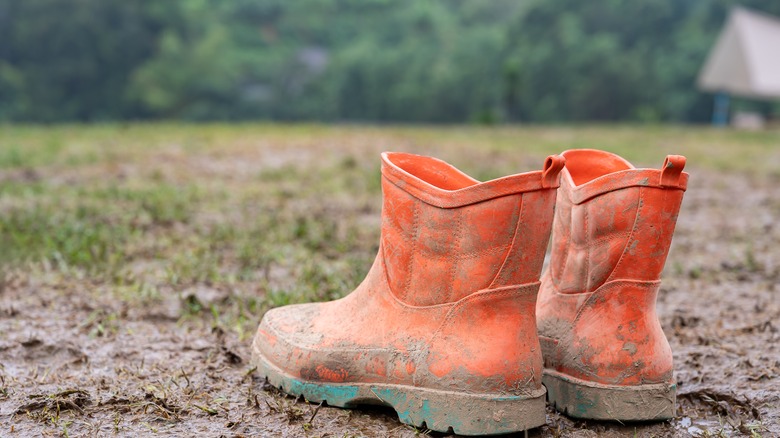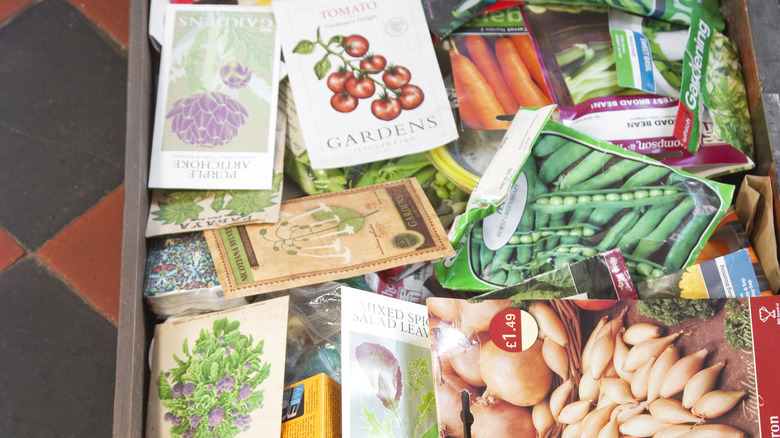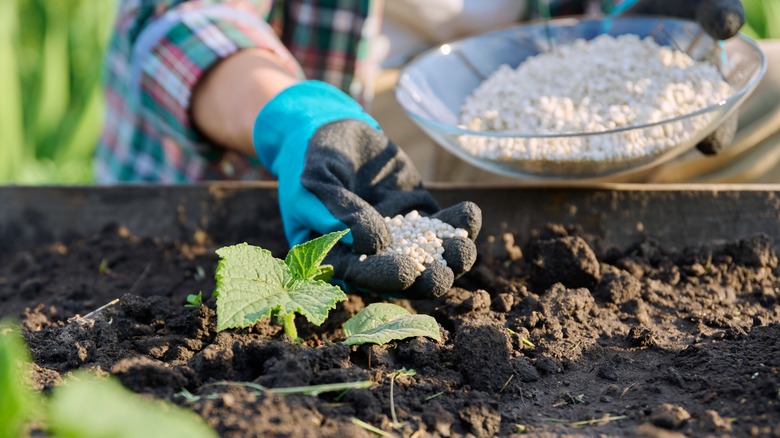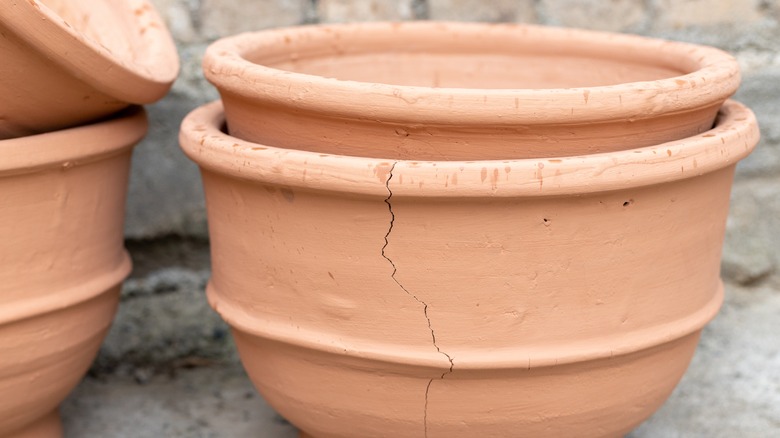Gardening Supplies To Get Rid Of For A Fresh Start Next Year
As fall winds your gardening efforts down for the year, it's a good time to reflect and prepare a fresh start for next spring. One of the best ways to set yourself up for success is by clearing out old, worn out gardening supplies. This way, you'll have the best tools and materials when you need them once the beginning of the season rolls around. Using old, inefficient equipment can potentially lead to poor results, which is why you should consider replacing worn out gardening tools, ineffective protective clothing, expired seeds and fertilizers, and broken containers and pots.
Going through all your gardening supplies can feel daunting, so give yourself some time to sift through the things you might not need anymore. You don't need to go in and throw out all your essential gardening tools, especially if they are items you use regularly. Instead, go through your supplies with intention and decide what you will keep and what needs to go. You can safely get rid of anything that's broken or nearing the end of its lifecycle. If you have two of the same tools or equipment, keep the one that's the most sturdy and works the best. Check the expiration dates on everything that has one and inspect your containers for damage and cracks. Since it is the end of the growing season, you'll have a good idea of what you used this year and what you didn't touch. Spending a little time and effort to go through your materials goes a long way, and you'll be well-prepared for a productive and enjoyable gardening season in the upcoming year.
Old garden tools
When it comes to going through your old garden tools at the end of the season to prepare for the next year, you'll want to begin with inspecting them for the extent of their wear and tear. Look for signs of rust, bent or loose handles, and splintering wood. Wear like this will just make tasks more difficult and could also lead you to accidentally hurt yourself. Any tools that are beyond repair you should go ahead and discard or repurpose in and around your home. Oftentimes, if they are made out of metal or plastic, you can recycle them at a recycling center if there's one in your area that accepts gardening tools. However, if you have tools that are still functional but you have too many of the same tool or they no longer meet your needs, consider donating them to your local community gardens, tool centers, schools, or anywhere in the community that might have a use for them.
If you've thrown out tools that you need to replace, it's worth considering making the investment in high-quality options that will last for many seasons. Gardening tools and equipment that are built to last not only save you money, since you won't be replacing them anytime soon, but they also make your gardening experience that much more enjoyable. Local garden nurseries and hardware stores are sometimes the best places to shop so you can physically handle the tools and see for yourself if they're sturdy, comfortable, and feel good in your hands. Do your research to find the best brand for your desired tool to make sure they are durable.
Worn out gardening clothes
Most gardeners have specific clothes they wear out in the garden that provide protection from the sun and weather and are appropriate for garden work. As you probably know, these articles of clothing can take an immense amount of wear. This is why it's important to assess whether it's time to repurpose or replace them altogether at the end of the season. You'll want to inspect any pants or overalls, shirts, hats, boots, coats, aprons, and gloves you wear outside. Somethings could potentially be patched up and sewn to avoid throwing them away, but that depends on the extent of the damage.
Your boots or shoes that you wear in the garden are one article you won't want to overlook. When you're planting your vegetables or cleaning out a garden bed, the last thing you want is cold, wet, cramping feet. So, if your boots have holes or if you've completely worn down the soles of them, it's probably time for a new pair. The same goes for your gloves. Holey, thin gloves probably aren't going to protect your hands from sharp tools, fencing, or thorns, or keep them warm and dry. The best gardening gloves should have a water repellent exterior, be well fitted to your hands, have slip resistant features, and perhaps have a cozy lining inside to keep your hands comfortable in the elements. You'll be excited come spring when you have your new clothes to wear in the garden and the old ones are long gone.
Out-of-date seeds
If it has been awhile since you've gone through your seeds, doing so at the end of the season when you're finished cleaning out the garden is a good idea. You can often find the date of when the seeds were packed on the physical seed package they came in. Most seed varieties remain viable for several years after their packing date, with many vegetable seeds lasting for three to five years. But that all depends on a few factors, including how you stored them and the type of seed. Seeds do have a limited shelf life, and as they age, their germination rates can significantly decline. Using older seeds can lead to poor germination and result in sparse plantings and weaker crops. You can perform a simple germination test by putting the old seeds in a wet paper towel, securing it in a Ziplock bag, and putting it in a warm spot for a few days to see how many seeds germinate. If it's less than 50%, it's probably best to toss them out.
When you're buying new seeds, you'll want to make sure you're sourcing them from reputable suppliers, which can guarantee high germination rates and healthier plants. Opting for heirloom and organic seed varieties can also offer superior flavor and resilience. If you don't use all the seeds in the year you buy them, you can properly store them to prolong their lifespan. Keeping your seeds in a cool, dark, dry place like a refrigerator or a dedicated seed storage container with moisture-absorbing packets will ensure they're ready for planting when the season begins.
Degrading fertilizer
Over time, your garden fertilizers can degrade, losing their potency and effectiveness. This is why determining how long you've had your fertilizer and the condition it's in is helpful to ensure your plants receive the nutrition they need next year. Clumping, changes in color, or a distasteful smell may indicate that you fertilizer is depleted or contaminated. While the fertilizer may have some nutrients left, proceeding to use this fertilizer can potentially lead to nutrient deficiencies in the plants in your garden, affecting their growth and overall health. The degraded fertilizer may also contain harmful bacteria that can corrupt the environment you use it on. So, evaluate your current fertilizer supply and dispose of any degraded fertilizers that are past their prime.
Before buying nutrients, you may want to perform a soil test to determine which nutrients your soil could be lacking. Based on the results of the soil test, you'll be able to choose the most appropriate type of fertilizer, whether it's balanced, an all-purpose formula, or one tailored to specific plants like flowers or vegetables. Organic material options like compost or well-rotted manure make for optimal choices, as they improve soil health and provide a slow-release source of nutrients. Synthetic fertilizers might also meet your nutrient needs but often require more frequent applications. Normally, you'll apply garden fertilizers in the early spring before planting and again throughout the growing season as needed. Starting the season with new and fresh fertilizer will have your garden thriving all year long.
Cracked and broken containers
Many gardeners (maybe you included) can attest to having an extensive collection of all sorts of planting pots. At the end of the season, as you clean your pots free from plant debris, it might also be a good time to examine your collection and throw out ones that have obvious substantial damage. Broken and cracked pots can sometimes harbor bacteria, fungi, and pests that could jeopardize the health of future plants. You can potentially recycle any plastic pots at the local retailer or nursery you bought them from. If you wanted to clean and sanitize a cracked ceramic or terracotta pot, you could either turn it on it's side to continue using as a planter or further break the pot down into smaller pieces. You can then use those shards in a decorative mosaic craft or add them to the bottom of a pot for better drainage. Also check out some other ways to repurpose planters inside and outside your home.
You'll want to clean any pots you intend to reuse in the upcoming season regardless of whether they're new or used. Used pots usually have leftover soil in them after you remove the plants. The soil or residual plant material can harbor bacteria and salts that can build up and discolor your pots. New pots also need a good rinse and sanitize, too. The pots could contain fungus or mold spores if they were previously stored in a damp environment, and the manufacturing process could have left residual debris as well. Washing your pots up at the end of the season will have them ready to go come spring.
